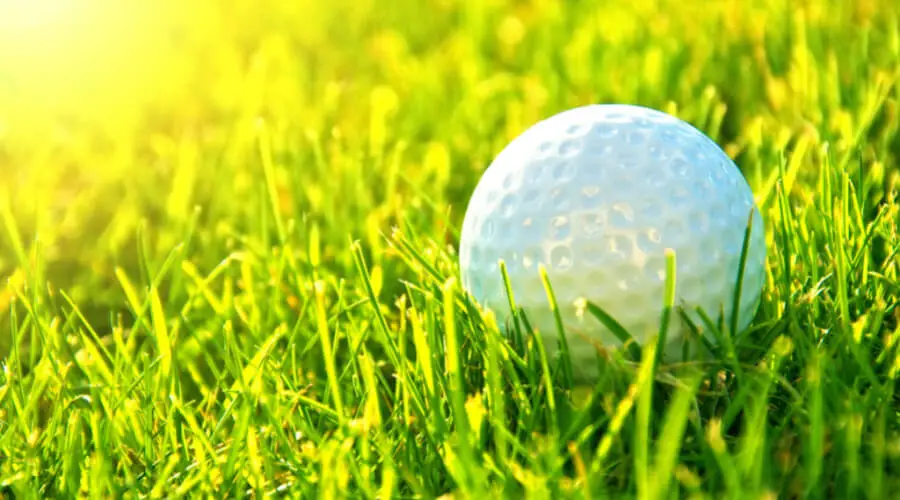Last Updated on October 9, 2023 by Alex PT
Golf balls have dimples to reduce air resistance and increase lift. The dimples create turbulence in the boundary layer of air, allowing the ball to travel farther and with better accuracy.
Reasons Why Golf Balls Have Dimples

Have you ever imagined how golf balls would perform without dimples all over its body? Seek no further as the reasons behind the innovation of dimples will be discussed below for more clarity.
Aerodynamics
As a science of the interaction of moving objects with the atmosphere, the turbulent boundary layer at the surface of the golf ball is formed by the presence of dimples. The turbulent flow acts on the gas molecules that exist in air, and therefore modifies its development. The dimples on a golf ball allow for longer air time between the ball and the surface of the clubhead compared to a smooth golf ball. This reduces drag force, allowing more distance between the swinger and the golf ball to travel.
Friction
Dimples on both sides of a golf ball make it easier to control the trajectory and spin rate. This allows the player more time to time their swing while in mid-air and also results in greater height and distance when striking the ball. Dimples in golf are strategically placed on both sides of the ball as well as at the bottom or “equator” and not random so that when you hit the ball, it doesn’t matter which way the ball is oriented in your stroke – all parts interact with the environment equally.
Creation Of A Thin Layer Of Air
The basic function of dimples of golf balls is to create a thin layer of air that sticks to the surface during the flight of the ball, increasing the lift and reducing the drag which ultimately permits the ball to travel higher and farther. Traditionally spherical, dimples create a turbulent boundary layer that effectively allows the air around the ball during flight to travel tightly as an attached airflow. This process reduces the drag which makes a dimple golf ball travel farther than a smooth one.
With the above narratives, it’s easy to say dimples decrease aerodynamic drag on the golf ball during flight and augment its lift to make it travel farther and quicker.
Why Do Golf Balls Have Different-Sized Dimples?
- Air Resistance and Lift:
The main reason for the presence of dimples on a golf ball is to reduce air resistance, also known as drag. When a golf ball is hit, it experiences two types of drag forces: skin friction drag and pressure drag. Dimples on the ball’s surface alter the airflow, reducing pressure drag by creating a turbulent layer of air. This turbulence delays the separation of airflow, allowing the ball to slice through the air more efficiently. - The Bernoulli Principle:
Dimples on a golf ball also create lift, thanks to the Bernoulli principle. This principle states that as air moves faster over a curved surface, the pressure on that surface decreases. When a golf ball with dimples is in flight, the airflow over the top surface of the ball is faster than the bottom surface. The pressure difference between the top and bottom surfaces generates lift, enabling the ball to stay in the air for a longer time and travel farther. - Uniformity vs. Variety:
Golf balls come in various designs, with dimples ranging from small to large, and even patterns with different shapes and depths. The dimple pattern greatly affects the ball’s flight characteristics. Balls with small dimples tend to produce a more stable trajectory and less spin, making them ideal for golfers seeking consistent ball flight. On the other hand, balls with larger dimples increase lift and provide more control, making them popular among professionals and those looking for enhanced shot-shaping abilities. - Distance vs. Control:
The size and pattern of dimples on a golf ball contribute to its overall aerodynamic behavior. Golf balls with larger dimples create more turbulent airflow, resulting in increased lift and decreased drag — a perfect combination for increased distance off the tee. Conversely, smaller dimples create less turbulent airflow, reducing lift and allowing for better control around the greens when precise shots are crucial. - Weather Conditions:
The choice of dimple size and pattern can also depend on weather conditions. On windy days, larger dimples help stabilize the ball’s flight against gusts of wind, making it easier for golfers to maintain accuracy and control. In contrast, smaller dimples offer more maneuverability in calm weather, allowing golfers to execute shots that require more finesse.
Does the Number of Dimples on a Golf Ball Matter?
Yes, the number of dimples on a golf ball matters, but it’s just one of many factors that influence a ball’s performance. Here are the details:
Dimple Count Impact:
- Aerodynamic Properties: Dimples on a golf ball affect its aerodynamic properties. More dimples generally create more turbulence in the boundary layer of air around the ball, which reduces air resistance (drag). This allows the ball to maintain lift and stay in the air longer.
- Lift and Distance: A golf ball with the right number and pattern of dimples generates lift, helping it achieve greater distance during flight. The optimal dimple configuration varies by ball design and is influenced by factors like dimple depth, shape, and arrangement.
- Spin Control: Dimples also play a role in controlling spin. The precise number and arrangement of dimples can influence the ball’s spin rate. Golfers often choose balls with specific dimple patterns to suit their playing style, whether they want more or less spin.
- Trajectory: Dimple count affects the trajectory of the golf ball. Balls with more dimples often produce a higher trajectory, which can be advantageous in certain situations, such as achieving maximum carry distance.
Other Factors to Consider:
- Dimple Shape and Depth: The shape and depth of dimples are crucial factors. Different dimple designs can affect how a ball responds to the air, influencing its lift, distance, and trajectory.
- Cover Material: The material used for the cover of the golf ball, whether it’s urethane or surlyn, also affects performance, and dimple interaction with the cover is essential.
- Ball Compression: Golf balls come in various compression levels, which impact feel and distance. Dimples must complement the ball’s compression to optimize performance.
- Swing Speed: A golfer’s swing speed influences how the ball interacts with dimples. Some dimple patterns may be more suitable for lower or higher swing speeds.
- Playing Conditions: Course conditions, weather, and altitude can impact how a golf ball performs, and dimple count may need to be adjusted accordingly.
FAQs
Below are the frequently asked questions on why golf balls have dimples. Let’s take a look at them!
Have Golf Balls Always Had Dimples
Golf balls are originally smooth until discoveries were made on why it doesn’t travel to a far distance. Air quickly separates from the smooth ball while turbulence created by the dimples delays separation.
How Many Dimples Are On A Golf Ball
It could range from 300 to 500 indentations’s primary function is to reduce air resistance and maintain lift to ensure efficient flight of the ball.
What Is The Purpose Of Dimples On A Golf Ball
Hitting a perfectly round golf ball may not go beyond 130-150 yards as it has a lot of drag in it. Dimples enhance the ball to travel farther as it reduce the drag by disrupting the air pattern around the golf ball when it is hit.
Why Do Golf Ball Dimples Reduce Drag
Lower pressure is created by dimples which enable air to move quicker on top of the ball during flight. Unlike perfectly round golf balls, a smooth flow of air is more permitted with the presence of dimples.
Is It Better To Have A Dimple On A Golf Ball
Absolutely. Dimples induce turbulence boundary around the ball which ultimately helps reduce the drag. Smooth golf balls won’t travel a far distance when hit and this makes dimple an essential part of the modern-day golf we enjoy today.
Concluding Remarks
The importance of dimples on a golf ball can not be overemphasized as they aid in lift and helps in the reduction of air resistance during the flight which ultimately enhances aerodynamic stability. Dimples on golf balls create turbulence which reduces the drag, and brings about a decrease in resistance that enables a swift and efficient flight of the ball.
References:
https://www.scientificamerican.com/article/how-do-dimples-in-golf-ba/
https://stitchgolf.com/blogs/a/why-are-there-dimples-on-golf-ball

Hi! I’m Alex PT. I hold a Bachelor’s degree in Sports Management from Indiana University and have over seven years of valuable experience working in a Sports Event Management Company. I founded SportBlurb with the passion for bringing you the latest, most insightful, and engaging content in the world of sports. So, whether you’re a die-hard fan or want to stay informed, I’ve got you covered!

